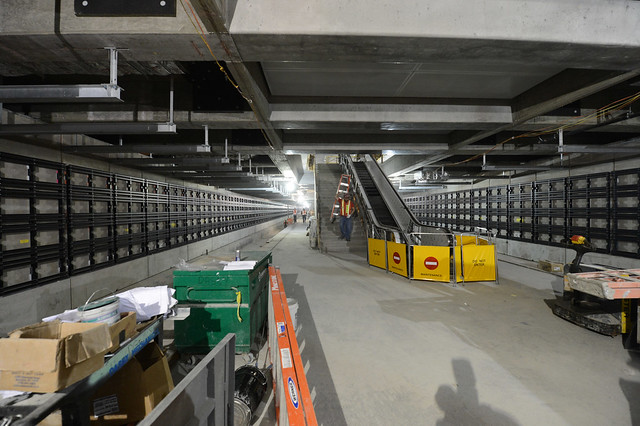
One Queens politician wants to convert this LIRR ROW into a light rail running from Glendale (shown here) to Long Island City.
Now that the head of the City Council’s Transportation Committee has opened the door to a light rail study, the floodwaters of potential political requests have been let loose. Barely had the pixels burned on Ydanis Rodriguez’s request when another council member — this one from Queens — called for a light rail investment in her borough. This one comes from Elizabeth Crowley, and it may highlight the pitfalls of Shiny New Thing syndrome.
The story comes to us from Gloria Pazmino and Dana Rubinstein writing in Politico New York. The two report:
In order to provide additional public transportation options, Crowley is proposing to use already-existing railroad tracks in her district to build a light rail line between Glendale and Long Island City along the Long Island Rail Road’s Montauk branch. “It’s a railroad that is in excellent condition that has no rail cars on it, so it’s a waste of track. It has no real use and there is potential for park-and-rides and development around the rail,” Crowley told POLITICO New York.
The rail line carried passengers between Long Island City and Jamaica stations in Glendale and Maspeth until the late 1990s, but service was discontinued due to low ridership. Currently, the track is used to transport freight overnight for only a few hours, Crowley said.
Citing the borough’s rapid growth and the increased need for public transportation, Crowley said installing a light rail would be much easier in her district due to the already-existing infrastructure and right of way. “We are very, very close to the city but it’s very difficult to get into Manhattan because it’s a transportation desert,” Crowley said. “More and more people are using their cars because it takes too long to take public transportation.”
This is a bit more of a problematic request than Rodriguez’s desire for a study. Crowley seems to have identified a route by examining a right of way that exists without really delving into why this right of way has no passenger service, and she doesn’t really explore a need here. Her idea seems to be to create a feeder light rail line from Glendale to the 7 in Long Island City via Maspeth. For what it’s worth, the Glendale LIRR station had just two daily riders at the time of its closure in 1998.
Would this help people get to Manhattan faster? What affect would this have on the already-crowded 7 train? Is it worth navigating the issue of shared freight and passenger service? And why would anyone spend the money to convert a heavy rail ROW that shuttered due to low passenger service into a light rail service that may not fair much better? These are questions that demand a rigorous analysis before this idea is anything more than idle musings, and while Crowley said the MTA “seemed receptive” of the idea, it’s not clear if there’s demand for this service or if Crowley is trying to think outside of the box (which in the realm of NYC transportation politics is much appreciated).
Meanwhile, there is some opposition brewing to the idea of light rail. It comes from Joan Byron, the Director of Policy at the Pratt Center for Community Development and a major proponent of bus rapid transit. Without holding her punches, Byron charged that light rail is simply a class-based approach to transit adoption. “Poor people and people of color ride the bus,” she said. “But we want something shiny and new that young white millennials will ride…You have to do something really shiny to get them not to drive.”
What’s particularly strange about Byron’s statement is its invocation of millennials. This generation — and in particular those who live in New York City — aren’t drivers or car owners. They already use transit at rates much higher than older residents of NYC (and cities in general across the country). Byron, who has a stake in beefing up the bus network, also undersells the psychological advantages of system that runs as a fixed-rail one via a dedicated right-of-way. Numerous studies have shown that these two elements alone draw ridership across racial and class lines. Buses simply aren’t the be-all and end-all of urban mobility issues.
Ultimately, light rail could be an answer to the city’s transportation cost and mobility issues, but it’s clear that many issues remain to explore before we understand where light rail would work and how. Both the Bronx and Staten Island are better candidates than one corridor in Queens, especially when you consider network effects, but perhaps light rail could work all over in various permutations as potential solutions. That’s what DOT will need to identify if they take up Ydanis Rodriguez on his request. It’s certainly worth considering.




 As the public deadline for completion of the Second Ave. Subway nears, stories about the W train have been popping up with near-monthly regularity. So even though the MTA
As the public deadline for completion of the Second Ave. Subway nears, stories about the W train have been popping up with near-monthly regularity. So even though the MTA 
